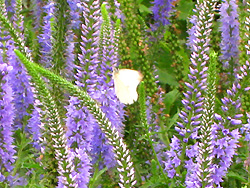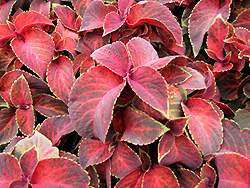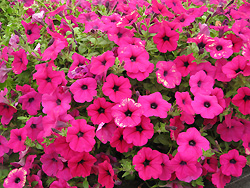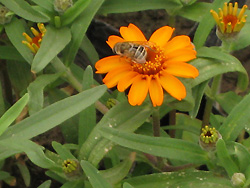
As many as 40 million flowers are scheduled to bloom during the Beijing Olympic Games, despite the hot and humid weather during the summer in the Chinese capital.
August and September in Beijing is a tough season for flowers. The excessive heat and rain tend to shorten the blooming of the flowers and also make flower breeding a difficult job," said Yao Shicai, a senior flower expert with the Beijing Research Institute of Landscape and Gardening (BRILG). "Besides, market demand in these two months is also a low period, so horticulturists don't try to grow things in this season and leave the city flower-lean."
During the Games, dozens of qualified local flower providers are ready to provide flowers of over 100 different species for the Olympic city.
Located about 20 minutes' drive away from Olympic Green, BRILG is set to provide 880,000 fresh flowers as well as 400,000 backup flowers for the Games, with a contract value totaling around 2 million yuan.
All Olympic flowers are those commonly seen in Beijing, though they have gone through certain kinds of crossbreeding in order to bloom in summer, explained Yong Wei, director of the marketing division of BRILG.
It's reported that most Olympics flowers are improved hybrids whose parent flowers include both local flowers and foreign flowers. Crossbreeding has made the flowers stronger so they can withstand the summer heat, bloom longer and be more resistant to possible diseases.

However, "most Olympic flowers are seasonal ones. They will die out after the Games," said Yong, which sounds somewhat pathetic, yet relieves concerns about the possible environmental fallout of crossbred flowers.
"For the perennial ones, as they are locally-based and already part of local eco-system, they naturally will not threaten the local eco-system", said Yong.
Yet flower providers still have a long way to go before they can finally take the load off their minds. Sophisticated horticulture means have made Olympic flowers immune to excessive heat and rain, but not heavy rain.
"Though we have backup flowers ready, we still hope extreme conditions such as heavy rain will not happen to ruin our delicate beauties," said Yao.
Completely at ease in front of the media, Yao reveals that his calm demeanor is earned through experience as he has been constantly interviewed about the Olympic flowers since the end of last year.
Yao also reveals the trick to make sure all flowers bloom exactly in Olympic duration.
"First, we need to select flowers which are able to bloom in August and plant them at the right time," he explains. "Then we need to make good use of growth hormones to slow down or accelerate the growth of flowers so that they can bloom to their full potential during the Olympics."
"All these growth hormones are hormones widely used in daily gardening and deliver no harm to the environment, human bodies or any animals," Yao said.
Having a Green Olympics

Flower providers began growing flowers June 20 and by July 15 most flowers will be put in place in and around Olympic venues. The Beijing Municipal Bureau of Landscape and Forestry (BMBLF) is in charge of the whole process.
"The reason we start growing flowers now is that an influx of foreign tourists is expected late July and the flowers are to coincide with their arrival," explained Zhou Jianping, Deputy Director with BMBLF, when he was overseeing the flowers planted in the Olympic Green on June 20.
"The fact that we divide the flowers and start planting a bit early before the start of the Games is also intended to avoid putting too much pressure on traffic," Zhou said.
Water is another concern besides traffic. While the maintenance of fresh flowers demands a large amount of water, Beijing itself is a water scarce city.
"We will water the flowers with reclaimed water where conditions permit", said Zhou. "For example, we use reclaimed water for those flowers planted in the venue areas in the Olympic Green."
Five million flowers are set to be planted around the venues in the Olympic Green, covering an area of up to 100,000 square meters.
We use automatic sprinklers to water flowers in the airport," said Zhou.
Wherever automatic sprinklers are possible, flower watering can be decreased to once a week from the current every two or three days, which will save water and reduce traffic, said Zhou.
A total of 6,000 flowerbeds will be in place at T2 and T3 as well as the Airport Highway.
Mixed response

Most Chinese are surprised at the large amount of flowers needed for Olympics, compared to their foreign counterparts when asked how they feel about the idea of decking out Olympics venues with flowers.
Salvatore Miranda, an Italian writer who is married to a Chinese woman, says it's understandable. "The Olympics are like a stage where countries can show their power. The western countries have had their time and now it's China's turn."
Charlotte Foucaut, a French woman who came to China a year ago and has been teaching in a Chinese college in a Beijing suburb, thinks the idea of having flowers is great from an aesthetic point of view. But she said, "If it threatens other flower species or if it represents some kind of threat of any kind to the environment or if it uses too much water then the answer is a huge NO."
Zhang Fangfang, a Chinese software engineer working with a Chinese IT company, said 40 million flowers is not a small number. Yet considering Beijing has a tradition to deck the city with flowers during such holidays as the National Day holiday and May Day holiday, she thinks that having flowers for the Olympics is just a continuation of the tradition. And the Games is no ordinary holiday, it's huge, so it's natural it needs more flowers.
Huang Qiliang, a Chinese interpreter working with the Official Broadcaster for the Olympics, said the large number of flowers is a huge waste of resources. "However, because not all citizens can be involved into the Games, smelling the flowers is a big celebration for them." He wishes the flowers would be given to citizens for free after the Games.
(China Daily July 10, 2008)